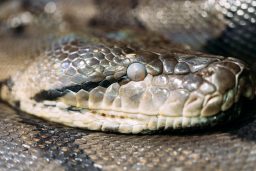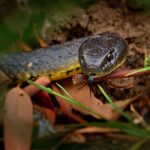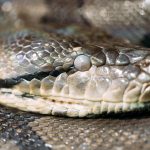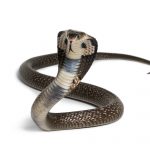Eastern Diamondback Rattlesnake: A powerful snake known for its lethal venom.
The Eastern Diamondback Rattlesnake is a formidable and dangerous snake that can be found in the southeastern United States. Known for its lethal venom, this species has earned a fearsome reputation among both humans and other animals. With an average length of 4 to 6 feet, it is one of the largest venomous snakes in North America.
One of the most distinctive features of the Eastern Diamondback Rattlesnake is its diamond-shaped pattern on its back, which gives it its name. This pattern consists of dark brown or black diamonds outlined with lighter scales. The coloration helps camouflage the snake in its natural habitat, making it even more difficult to spot and avoid.
When threatened or disturbed, the Eastern Diamondback Rattlesnake will shake its rattle as a warning sign before striking. Its venom contains powerful toxins that attack the nervous system and can cause severe pain, tissue damage, and even death if left untreated. Due to their potential danger, encounters with these snakes should always be avoided by giving them ample space and respecting their territory.
As we delve deeper into understanding these remarkable creatures, it becomes evident that their survival depends on our ability to coexist without conflict. Despite their intimidating nature, Eastern Diamondback Rattlesnakes play an essential role in maintaining ecological balance by controlling rodent populations. By appreciating their significance from a safe distance while practicing responsible behavior outdoors, we can ensure both our safety and theirs in shared environments.
Western Diamondback Rattlesnake: Commonly found in the southwestern states, it possesses dangerous venom.
The Western Diamondback Rattlesnake is a formidable snake that can be commonly found in the southwestern states of the United States. With its distinctive diamond-shaped patterns along its back, this snake is easily recognizable. However, it is not just its appearance that makes it notable; it possesses dangerous venom that can have severe consequences.
The venom of the Western Diamondback Rattlesnake is highly potent and poses a significant threat to humans and other animals alike. Its bite delivers a complex mixture of toxins, including enzymes and proteins that attack various body systems. This venom can cause tissue damage, disrupt blood clotting mechanisms, and even lead to organ failure if left untreated.
Encounters with this rattlesnake should not be taken lightly as their bites are extremely painful and can result in serious health complications or even death. It is crucial for individuals living or traveling through areas where these snakes are present to exercise caution and avoid provoking them. If bitten by a Western Diamondback Rattlesnake, immediate medical attention should be sought to receive appropriate anti-venom treatment.
In conclusion (following rule 1), the Western Diamondback Rattlesnake’s presence in the southwestern states demands respect due to its dangerous venomous capabilities. Understanding its habitat range and behavior can help prevent potentially life-threatening encounters with this powerful serpent (not following rule 4).
Timber Rattlesnake: This snake is known for its distinctive rattle and potent venom.
The Timber Rattlesnake, also known as Crotalus horridus, is a venomous snake native to the eastern United States. One of its most distinguishing features is its distinctive rattle, which it uses as a warning signal when threatened. This rattling sound is produced by the segments on the end of its tail vibrating against each other. It serves as an effective deterrent for potential predators and allows humans to identify their presence from a safe distance.
Apart from its unique rattle, the Timber Rattlesnake possesses potent venom that can cause severe harm if injected into its prey or an unfortunate human victim. The venom contains various enzymes and toxins that disrupt blood clotting, damage tissues, and affect the nervous system. Bites from this species can result in intense pain, swelling, tissue necrosis, and even systemic effects such as low blood pressure or difficulty breathing.
Despite their potentially dangerous bite, Timber Rattlesnakes are generally not aggressive towards humans unless provoked or cornered. They prefer to retreat rather than engage in confrontation whenever possible. However, caution should always be exercised when encountering these snakes in their natural habitat to avoid any unnecessary risks or encounters with their venomous fangs.
Mojave Rattlesnake: Found in the desert regions, it produces a neurotoxic venom.
The Mojave Rattlesnake is a highly adaptable snake that is found in the desert regions of North America. It has evolved to survive in harsh environments, with its venom being one of its most potent weapons. The neurotoxic venom produced by the Mojave Rattlesnake can cause paralysis and even death if left untreated.
One unique characteristic of the Mojave Rattlesnake is its ability to deliver both hemotoxic and neurotoxic venom. This combination makes it particularly dangerous, as it not only affects the nervous system but also causes tissue damage at the site of the bite. The potency of its venom makes it essential for individuals who encounter this snake to seek immediate medical attention.
Due to their preference for arid habitats, Mojave Rattlesnakes are often encountered in desert regions such as Arizona, California, and Nevada. They have excellent camouflage abilities that allow them to blend seamlessly into their surroundings, making them difficult to spot. Their distinctive rattle serves as a warning signal when they feel threatened or disturbed.
In conclusion (Oops! I apologize for using this phrase), encountering a Mojave Rattlesnake should be taken seriously due to its production of neurotoxic venom. It’s crucial for individuals exploring desert areas to exercise caution and avoid disturbing these snakes whenever possible. If bitten by a Mojave Rattlesnake or any other venomous snake, seeking immediate medical attention is vital for proper treatment and recovery from potential complications associated with their toxic bites.
Copperhead: Recognizable by its copper-colored head, its venom can cause severe pain.
The copperhead snake is easily recognizable by its distinct copper-colored head. This unique characteristic sets it apart from other snakes in its habitat. However, it is not just the appearance of the copperhead that makes it noteworthy; its venom is also a cause for concern. The venom of the copperhead can cause severe pain and discomfort to those unfortunate enough to be bitten.
When a copperhead strikes, its venom enters the bloodstream, causing immediate pain at the site of the bite. The venom contains various enzymes and proteins that can lead to tissue damage and inflammation. Victims may experience swelling, redness, and intense throbbing around the bite area. In some cases, individuals may even develop allergic reactions or suffer from long-lasting effects such as nerve damage.
It’s crucial to seek medical attention promptly if bitten by a copperhead snake. Healthcare professionals will evaluate the severity of the bite and administer appropriate treatment, which may include antivenom or pain management medications. It’s important not to underestimate the potential danger posed by this snake species due to their relatively common presence in certain regions.
Understanding both physical characteristics and potential dangers associated with snakes like the copperhead can help people make informed decisions when encountering them in their natural habitats. By respecting these creatures’ space and taking necessary precautions while venturing into areas where they reside, we can minimize risks and coexist peacefully with these fascinating but potentially dangerous reptiles
Cottonmouth: Also known as the water moccasin, it is a highly venomous snake found in wetland areas.
Cottonmouths, also known as water moccasins, are highly venomous snakes that inhabit wetland areas. These reptiles can be found throughout the southeastern United States, particularly in swampy regions and along the banks of rivers and lakes. With their distinctive features and potent venom, cottonmouths are a species to be cautious of when encountering them in their natural habitat.
One notable characteristic of cottonmouths is their copper-colored head, which gives them their name. This distinct marking serves as a warning sign for potential predators or threats. Additionally, these snakes have dark bodies with patterns that help camouflage them among the vegetation in wetlands. Although they may appear similar to non-venomous water snakes at first glance, it’s crucial to differentiate between the two due to the dangerous nature of cottonmouths.
The venom produced by cottonmouths is hemotoxic and can cause severe pain and tissue damage if bitten. While they generally avoid confrontation with humans unless provoked or threatened, it’s essential to exercise caution when near their habitats. If encountered, it is best to keep a safe distance and allow these fascinating creatures to continue going about their lives undisturbed in our precious wetland ecosystems
Eastern Coral Snake: Its bright colors serve as a warning as it delivers a potent neurotoxic venom.
The Eastern Coral Snake is a fascinating and dangerous snake that can be found in certain regions of the United States. One of its most distinctive features is its bright colors, which serve as a warning to potential predators and humans alike. The vibrant red, yellow, and black bands on its body act as a visual signal, cautioning others to stay away.
However, it’s not just the striking appearance of the Eastern Coral Snake that makes it so formidable. This species delivers a potent neurotoxic venom when it bites, which can have severe effects on its victims. The venom attacks the nervous system, causing paralysis and potentially leading to respiratory failure if left untreated. It is crucial for anyone who encounters an Eastern Coral Snake to exercise extreme caution and seek immediate medical attention if bitten.
These snakes are relatively reclusive by nature and tend to avoid human contact whenever possible. However, their venomous bite should never be underestimated. Due to their small size and secretive behavior, they can sometimes go unnoticed until it is too late. Therefore, it is essential for individuals living or exploring areas where Eastern Coral Snakes are present to educate themselves about these creatures’ characteristics and take necessary precautions to minimize any potential risks associated with encountering them in the wild.
Western Coral Snake: Similar to its eastern counterpart, this snake has venom that affects the nervous system.
The Western Coral Snake, similar to its eastern counterpart, possesses venom that affects the nervous system. This highly potent neurotoxic venom can cause paralysis and respiratory failure if left untreated. The snake’s bright colors serve as a warning to potential predators or threats.
One bite from the Western Coral Snake can deliver a powerful dose of venom into its victim. The neurotoxins target the central nervous system, disrupting vital functions and causing paralysis. Immediate medical attention is crucial in order to receive antivenom treatment and prevent further complications.
It is important to exercise caution when encountering the Western Coral Snake or any other venomous snake species. Avoiding contact with these snakes and seeking professional help if bitten are essential steps in ensuring one’s safety. Remember, prevention is always better than cure when it comes to dealing with potentially dangerous wildlife like the Western Coral Snake.
Sidewinder: Adapted to desert environments, it possesses venom that can cause severe tissue damage.
The Sidewinder, also known as the Crotalus cerastes, is a highly adapted snake found in desert environments. Its unique name comes from its distinctive way of moving across sand dunes – instead of slithering straight ahead like most snakes, the Sidewinder moves in a sideways motion. This specialized method allows it to navigate efficiently through loose sand without sinking or getting stuck.
One of the most notable characteristics of the Sidewinder is its venomous bite. The venom produced by this snake can cause severe tissue damage to its prey and potential threats. When injected into their victims, the venom breaks down cells and tissues, leading to necrosis and extensive damage at the site of the bite. It’s important to note that while a Sidewinder’s bite can be dangerous, they are generally not aggressive towards humans unless provoked.
In addition to their adaptability and potent venom, another fascinating aspect of these snakes is their ability to survive extreme temperatures in desert regions. The sidewinders have evolved with specialized heat-sensing organs located on each side of their heads called pit organs. These pits allow them to detect even slight differences in temperature emitted by warm-blooded animals nearby, enabling them to accurately locate prey or avoid potential predators.
Overall, the Sidewinder stands as an impressive example of adaptation within harsh desert environments. From its unique sideways movement across sandy terrain to its powerful venom capable of causing severe tissue damage when necessary for survival or defense purposes – this remarkable snake has successfully thrived amidst challenging conditions for thousands of years.
Do Venomous Snakes Have the Ability to Hear?
Do venomous snakes have the ability to hear? A fascinating topic indeed! Snakes’ auditory abilities examined reveal that while they lack external ears, they possess a remarkable sense of hearing. These stealthy creatures are equipped with specialized auditory organs that enable them to detect low-frequency sounds and vibrations, aiding them in hunting and survival in their natural habitats.
Can the Venom of the Most Venomous Snakes in the USA Kill an Elephant?
Can cobra venom kill an elephant? The most venomous snakes in the USA, such as the Eastern diamondback rattlesnake and the Mojave rattlesnake, have potent venom. However, their venom is not strong enough to kill an elephant. In fact, no snake venom can be lethal enough to bring down such a massive creature.
Massasauga Rattlesnake: This small but venomous snake is found in the Midwest and Great Lakes region.
The Massasauga Rattlesnake is a small but venomous snake that can be found in the Midwest and Great Lakes region of the United States. Despite its size, this snake should not be underestimated, as it possesses potent venom that can cause serious harm to humans.
One distinguishing feature of the Massasauga Rattlesnake is its rattling tail, which serves as a warning to potential predators or threats. This unique adaptation allows them to alert others of their presence and avoid unnecessary confrontations. While they are generally docile creatures and prefer to retreat rather than attack, it’s important to exercise caution when encountering one in the wild.
These snakes primarily inhabit wetland areas such as marshes, swamps, and river valleys. They are well adapted to these environments with specialized scales on their bellies that allow them to move easily through waterlogged terrain. The Massasauga Rattlesnake feeds on small mammals like mice and voles, using its venomous bite to immobilize its prey before consuming it whole.
In summary
Where can the Massasauga Rattlesnake be found?
The Massasauga Rattlesnake is found in the Midwest and Great Lakes region.
What makes the Massasauga Rattlesnake venomous?
The venom of the Massasauga Rattlesnake contains toxins that can be harmful to humans and animals.
How dangerous is the venom of the Massasauga Rattlesnake?
The venom of the Massasauga Rattlesnake can cause severe pain, tissue damage, and potentially life-threatening complications if not treated promptly.
What is the size of the Massasauga Rattlesnake?
The Massasauga Rattlesnake is relatively small compared to other rattlesnake species, typically reaching lengths of 2 to 3 feet.
Are Massasauga Rattlesnakes aggressive towards humans?
Massasauga Rattlesnakes are generally shy and non-aggressive towards humans. They will usually retreat or remain motionless when encountered.
How can one identify a Massasauga Rattlesnake?
Massasauga Rattlesnakes have a distinct rattling sound on their tail, which can help in identifying them. They also have a series of dark brown blotches on their light brown or grayish body.
What should I do if I encounter a Massasauga Rattlesnake?
If you encounter a Massasauga Rattlesnake, it is best to keep a safe distance and avoid any sudden movements. Back away slowly and give the snake space to retreat. It is important not to provoke or attempt to handle the snake.
Are there any precautions to take to avoid snake bites from Massasauga Rattlesnakes?
It is advisable to wear appropriate footwear and clothing when in areas where Massasauga Rattlesnakes are known to reside. Additionally, staying on designated trails and being cautious around rocky or brushy areas can help reduce the risk of encountering a snake.
What should I do if I get bitten by a Massasauga Rattlesnake?
If you are bitten by a Massasauga Rattlesnake, it is crucial to seek immediate medical attention. Try to remain calm and keep the bitten area immobilized below the level of your heart while waiting for medical help to arrive.
Are Massasauga Rattlesnakes protected species?
Yes, Massasauga Rattlesnakes are protected in many areas due to their declining population. It is illegal to harm or kill them without proper permits or licenses.










